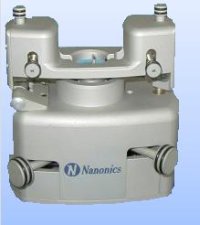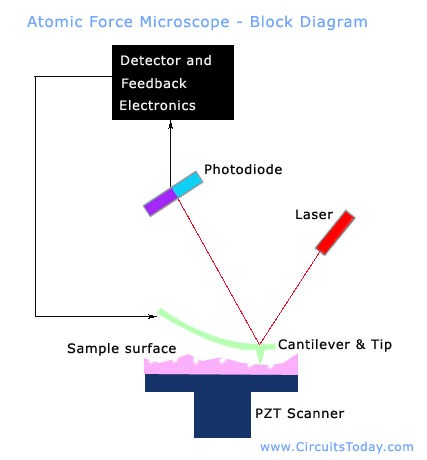The Atomic Force Microscope (AFM)
What are its Uses in Microscopy today? Advantages and Disadvantages
An atomic force microscope is a type of high resolution scanning probe microscope that has a resolution that you can measure in fractions of a nanometer.
It was pioneered in 1986 by Nobel Prize Winner Gerd Binnig along with Calvin Quate and Christoph Gerber.
Atomic Force Microscopy
One of the most important tools for imaging on the nanometer scale, Atomic Force Microscopy uses a cantilever with a sharp probe that scans the surface of the specimen.
When the tip of the probe travels near to a surface, the forces between the tip and sample deflect the cantilever according to Hooke’s law.

Nanonics.co.il
Atomic force microscopy will measure a number of different forces depending on the situation and the sample that you want to measure.
As well as the forces, other microscopes can include a probe that performs more specialized measurements, such as temperature.
The force deflects the cantilever, and this changes the reflection of a laser beam that shines on the top surface of the cantilever onto an array of photodiodes. The variation of the laser beam is a measure of the applied forces.
Contact and Non-Contact Modes
There are two primary modes of operation for an atomic force microscope, namely contact mode and non-contact mode depending on whether the cantilever vibrates during the operation.
In contact mode, the cantilever drags across the sample surface and it uses the deflection of the cantilever to measure the contours of the surface.
To eliminate the noise and drift that can affect a static signal, low stiffness cantilevers are used, but this allows strong attractive forces to pull the tip to the surface. To eliminate this attraction, the tip is in contact with the surface where the overall force is repulsive.
In non-contact mode, the tip vibrates slightly above its resonance frequency and does not contact the surface of the sample. Any long range forces, like van der Waals forces, decreases the resonant frequency of the cantilever.
A feedback loop system helps to maintain the oscillation amplitude constant by changing the distance from the tip to the sample. Recording the distance between the tip and sample at each point allows the software to construct a topographic image of the sample surface.
Most samples will form a layer of moisture on the surface if stored at ambient conditions, and this can make it difficult to measure the sample accurately.
If the probe tip is close enough to detect the short-range forces then it is close enough to stick to the moisture. One way around this is tapping, or dynamic contact mode.

Tapping Mode
In tapping mode, the cantilever uses a piezoelectric element mounted on the top to oscillate it at near to its resonance frequency with an amplitude of up to 200nm.
The forces cause the amplitude to decrease as the tip gets close to the surface, and the height of the cantilever adjusts to keep the amplitude constant.
This tapping results in less damage to the sample than contact mode and is more accurate than non-contact mode when moisture is present on a sample.
AFM Advantages
The atomic force microscope is a powerful tool that is invaluable if you want to measure incredibly small samples with a great degree of accuracy.
Unlike rival technologies it does not require either a vacuum or the sample to undergo treatment that might damage it.
At the limits of operation however, researchers have demonstrated atomic resolution in high vacuum and even liquid environments.
AFM Disadvantages
One of the major downsides is the single scan image size, which is of the order of 150x150 micrometers, compared with millimeters for a scanning electron microscope.
Another disadvantage is the relatively slow scan time, which can lead to thermal drift on the sample.
As the technology matures, researchers are relying on there being progress instrumentally, requiring improved signal-to-noise ratio, decreased thermal drift, and better detection and control of tip-sample forces, including the use of sharp probes.
Novel solutions are steadily improving these performance issues.
To further your understanding, you are welcome to follow this straight forward visual tutorial available online.
Manufacturers
Many suppliers manufacture an atomic force microscope, including Agilent Technologies, Angstrom Advanced, NanoScience Technologies and Park Systems (who made the first commercially available AFM).
Some of these systems include:
Agilent 6000ILM Atomic Force Microscope
- Multiple imaging modes
- Simple point-and-shoot AFM imaging based on optical view
- Overlay of light microscopy and AFM images
- Motorized stage
Angstrom Advanced AA2000 Atomic Force Microscope
- Large sample size
- Fast Ethernet connection to computer
- Multi-function including AFM and lateral force microscope (LFM)
- Online real-time 3D images
NanoScience Nanosurf EasyScan 2 FlexAFM
- Cameras Illuminate tip and sample area
- Pre-aligned optics
- Multiple white LEDs illuminate sample
- Eight optional modular scanners that can be swapped as required including AFM and scanning tunneling microscope
Park Systems XE-Bio
- Combines non-contact AFM with Ion Conductance Microscopy and inverted optical microscopy
- Modular design for non-invasive in-liquid imaging
Cost
In order to protect pricing information, it is not freely available. All these manufacturers ask that you contact them to request a quote so that they can assess your requirements and quote accordingly.
The atomic force microscope is a highly advanced piece of equipment operating at the limits of our detection abilities along with scanning tunneling microscopes.
Either technology has advantages and disadvantages over the other which researchers and manufacturers are endeavoring to overcome.
See Also:
Magnetic Force Microscopy - A variant of AFM
Atom under the Microscope page for more info
Return from Atomic Force Microscope to Scanning Probe Microscope
Return to Best Microscope Reviews Home
Find out how to advertise on MicroscopeMaster!




